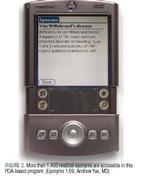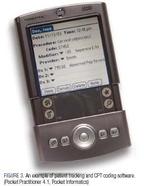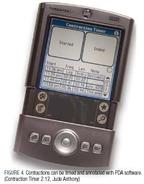Is there a PDA in your future?
PDA PROGRAMS
Is there a PDA in your future?
By Roger P. Smith, MD
Personal digital assistants are making life a whole lot easier for ob/gyns, medical students, and residents. Beyond the popular drug reference databases available on PDAs are hundreds more programs that time contractions, track menstrual cycles, keep experience stats, or simplify CPT coding.
Even as high-tech devices have shrunk in size, their potential applications have soaredas the growth of the personal digital assistant (PDA) illustrates so dramatically. Not widely known a few years ago, PDAs are now carried by colleagues to manage appointments, keep track of business contacts, document business expenses, send or receive faxes, process documents, or to perform any number of tasks once reserved for desktop or larger computers. Taking this trend one step further has been the recent surge in hybrid devices that combine the functions of cellular devices with those of the traditional PDA and even digital cameras.
As a physician, you can choose from more than 1,000 PDA titles to keep track of hospitalized patients, record notes to be placed in a patient's records, enhance resident education, or to access drug dosing or other information whenever you're away from your desk.1,2 But despite the many potential medical applications for the PDA, at the moment its most practical global uses fall into just a few categories. My goal here is to look at these key applicationsas well as the more limited applications that are specific to our field.
Choosing a practical PDA program
The most practical medical applications boil down to contact management (phone lists and related information), scheduling, drug and other medical information, patient and medical record keeping, and communication.
Contact management. The business community spurred the growth of one of the first wide applications for the PDA: contact management. What once resided on your Rolodex can now be manipulated in ways impossible with mechanical systems. Contact information on pharmaceutical representatives, referring physicians, hospital dictation lines, phone numbers for laboratories, the operating room, and even local restaurants clog our memories and desktops. With a PDA, these can be grouped, sorted, and passed on electronically to other PDAs or desktop machines. A change you make in one place can automatically be updated in all locations, so you won't ever make the social faux pas of calling a referring physician's new spouse by the ex-spouse's name. There are even programs that will scan a business card and extract the information printed on it, placing names, addresses, and phone numbers in their proper places in the electronic file.
Scheduling. Another PDA application that began in the business community, schedule maintenance programs are even used by "connected" teenagers these days. PDA versions have replaced the once trendy day planners. Theoretically, you could place your office schedule of patients onto a PDA. In the real world, however, the fluid nature of these schedules and the patient privacy concerns that carrying a copy around with you might raise tend to limit use to non-patient schedules. Nonetheless, the ability to keep a schedule of meetings, travel, birthdays, and other events on a single calendar that can be automatically synchronized between your office desktop machine, your pocket device, a laptop computer for travel, and your home office makes this an extremely convenient application.
As hybrid devices that combine computing and communications proliferate, you can download this information to your cellular telephone (assuming your PDA doesn't act as a phone itself). With compatible software and an Internet connection, you can even use the PDA to invite others to a meeting at the very moment you enter the date and time into your own calendar. Like a paper-based system, the biggest drawback to electronic scheduling is the often burdensome time required to enter and maintain the record. But on the plus side, the more time you spend, the richer the listand the more accurate the information.
Drug information. Perhaps you have become familiar, if not dependent, on a free PDA-based drug information database like ePocrates Rx (Figure 1) or on The Physicians' Desk Reference. These offer rapid access to practical information on both prescription and nonprescription medications. Searchable by name, class, indication, and other methods, these programs offer features that a printed document could notlike the ability to check for multiple drug interactions.

Medical data. For those with sufficient PDA memory, several suppliers offer medical textbooks in complete or abstract form. Unfortunately for ob/gyns, most of the currently offered texts are from other fields. Examples include clinical texts like Harrison's Principles of Internal Medicine and ICD-9-CM coding manuals.3 Some programs actually allow you to apply rules and algorithms to establish a diagnosis or assist in management decisions. There's also a handy freeware program that lists more than 1,400 medical eponyms (Figure 2). Medical dictionaries in one form or another are available for palm-top platforms, but are usually not "musts" to carry around. Translation dictionaries are available for several languages, but their capabilities are somewhat limited by both the platform and the memory available in most handheld devices. Still, these have their place if you are not a native speaker of the language of the patient at hand (or a foreign traveler). Realize though, most of these are general vocabulary-oriented, so they have few detailed medical terms and even fewer ob/gyn-specific ones.

Record keeping. Several PDA-based options exist for tracking patient lists, procedures, and billings. The data that you enter at the bedside, operating, or delivery room can later be used to construct patient lists and experience forms (for residents). Some programs are most valuable for physicians in training and those compiling case lists for use in credentialing. Most allow you to download the accumulated information into a desktop module for storage, manipulation, and printing. But their value to many clinicians is undermined by the fact that the lists produced are not in the form most certifying boards require. A number of integrated desktop and PDA packages might better suit the needs of ob/gyns in practice.4 If your goals are patient tracking or establishing correct CPT coding, check out the PDA software available (for a fee) from various commercial vendors ( Figure 3).

Communication. The line between palm-top and communications devices is rapidly vanishing. Many PDAs can function as cellular telephones or can connect wirelessly to the Internet. Similarly, many cellular telephones now offer Web services, contact and schedule management, and computing that would normally be associated with a computing device. At the moment, the relatively high cost of airtime, reduced bandwidth (transmission speed), small device displays, and the less-than-extensive software options limit the value of these systems. For most physicians, the simpler (and less expensive) single-purpose devices still suffice, leaving these high-tech hybrids for the more trendy techies.
Special applications of interest to ob/gyns
Several free PDA applications will calculate and track gestational age from menstrual history or ultrasound data, calculate body mass index, provide solutions to complex medical formulas (like anion gap, free water deficit, or A-a gradient), or convert data from metric to English and back again. A simple example of such an integrated system targeted toward medical students but useful for everyone is Pocket Ob/Gyn.5 This program has the essentials needed for daily roundsincluding normal and complicated obstetrics, gynecology, gynecologic oncology, ultrasound, and infertility. It includes tables that summarize fetal growth, formulas for calculating drug dosages, electrolyte management guidelines, and other basic facts.
The options seem limited only by the inventiveness of the commercial (and sometimes amateur) programmers who see a need. There are even programs for tracing a patient's menstrual cycle to assist with conceptionor avoid itwhile others help you and your patient lose those stubborn pounds by tracking caloric and nutrition intake. Yes, there are even PDA applications that will help you time contractions in labor (Figure 4).

Web site resources
Several Web sites offer tracking of software, reviews, and links to suppliers that can be useful if you are looking for specific applications or just like to browse.6,7 The Office of Academic Computing at Johns Hopkins University offers links to many PDA applications of interest to those in our field, including a PDA version of the Gail Model for predicting breast cancer risk.8 (This site even has PDA resources that list bioterrorism agents and the appropriate treatments.) Several other universities, including the University of Louisville, offer similar collections of PDA software, including ob/gyn-specific ones.9 Finally, don't forget to ask your fellow ob/gyn PDA owners what software they've found most helpful.
REFERENCES
1. Helwig Al, Flynn C. Using palm-top computers to improve students' evidence-based decision making. Acad Med. 1998;73:603-604.
2. Smith MP, Sheplock GJ. The anesthesiologist's guide to palm computing. Reg Anesth Pain Med. 1999;24: 458-462.
3. Mobipocket Medical eBooks. Available at: http://www.mobipocket.com/en/eBooks/medical.asp . Accessed June 19, 2003.
4. Handheldmed. Available at: http://www.handheldmed.com/ Accessed June 19, 2003.
5. Pocket OB/GYN. Available at: http://www.lww.com/productdetailresults/1,2265,512532430,00.html . Accessed June 19, 2003.
6. PalmGear.com. Available at:http://www.palmgear.com/ . Accessed June 19, 2003.
7. PocketPC. Available at: http://www.microsoft.com/mobile/pocketpc/default.asp . Accessed June 19, 2003.
8. Johns Hopkins Medicine, Office of Academic Computing PDA Resources. Available at: http://oac.med.jhmi.edu/oac/pda3.html . Accessed June 19, 2003.
9. University of Louisville, School of Medicine, PDA Initiative. Available at: http://www.medschool.louisville.edu/palm/Medical.htm . Accessed June 19, 2003.
Dr. Smith is Professor, Vice Chairman, and Program Director, Department of Obstetrics and Gynecology, The University of Missouri-Kansas City, Truman Medical Center, Kansas City, Mo.
Roger Smith. Is there a PDA in your future? Contemporary Ob/Gyn Dec. 1, 2003;48:55-67.
